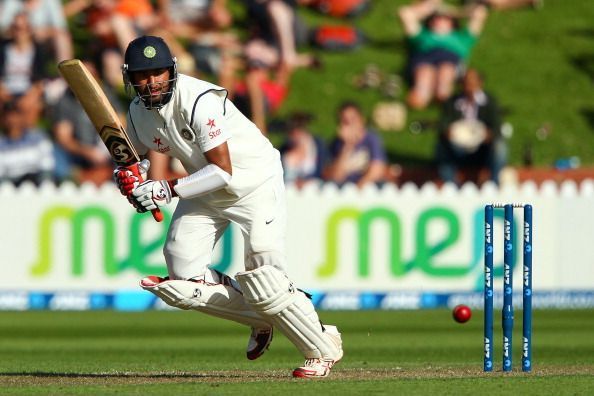
Cheteshwar Pujara's IPL conundrum: Why India's no. 3 should not play in the IPL
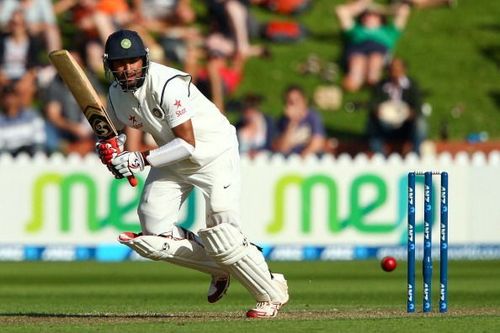
Going into IPL 2017, rumours were rife that Cheteshwar Pujara might find a place for himself given the stupendous home season he had. Pujara with a base price of Rs. 50 lakh had gone unsold in the auction in February but there were possibilities that he might become a valuable last-minute acquisition for quite a few franchises.
The Delhi Daredevils and Kings XI Punjab were on the lookout for top order batsmen, the latter being the last franchise for which Pujara had played in the IPL.
But contrary to all rumours, Pujara went unsold and had to sit out of Indian cricket’s most high-profile franchise-based tournament yet again.
Many believed that he deserved a look in given the incredible domestic form he was in while others felt that it would be a blessing in disguise for India’s no. 3 in Tests in the long run.
Missing out on the big money
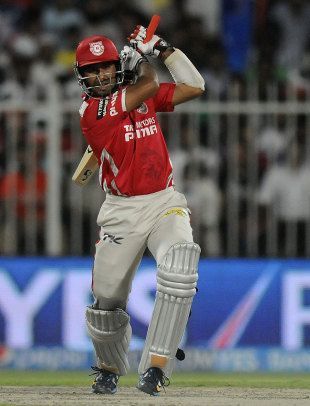
One of the most astounding developments that the IPL has brought in is obviously the amount of cash which is on offer. BCCI’s cash cow has made both domestic and international cricketers very rich, not to mention the fact that their IPL salaries are much more than an entire season of international cricket.
If you don’t play in the IPL, you miss out on the money train. Just to put predictions into perspective, Pujara’s earnings from an entire season of Test cricket, from October 2016 to September 2017, is expected to be around Rs. 4.25 crore, if he plays all the Tests.
Limited overs specialists earned much more than that from a single IPL season in 2017 — Suresh Raina earned 9.5 crore, Mohit Sharma earned 6.5 crore, Ambati Rayudu earned 6 crore, Robin Uthappa earned 5 crore, and Ashish Nehra earned 5.5 crore.
None of them seem to be in contention for the Indian team at present which means that a single season of franchise-based cricket can now earn you way more than an entire year of international cricket.
That seems to be lopsided justice for Pujara who is now one of India’s finest cricketers in the longest formats of the game. If you do not incentivise players like him, the cry that Test cricket is grossly ignored by cricket administrators will only get louder.
Pujara, however, seems to be unperturbed about his bank balance and finds fulfilment in his performances. Speaking to the Espncricinfo, he says, "Many wanted India to win, the Australia series was tough," he said. "To have done well in those matches and gained the respect of teammates and oppositions brings about a satisfaction that can't be matched.
“The feeling that comes from performing when the team needs you to can't be compared. I don't want to talk about how much others are earning or doing. What I've earned is precious to me."
Brilliant performances
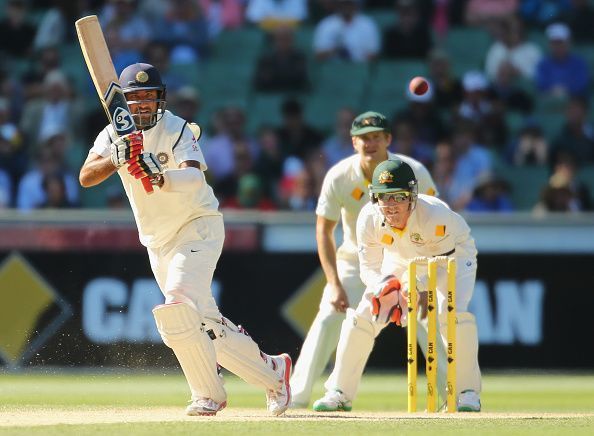
What stands out for Pujara is his remarkable consistency which makes him a vital player at no. 3 in Tests. While the inevitable comparisons with Rahul Dravid may still be a tad ambitious, the fact that he ensures Dravid’s absence is not felt is a big achievement in itself.
Pujara, because of his class and consistency, is now perhaps the most vital member of the Test side. His anchoring at number 3 is the fulcrum around which the more flamboyant players like Kohli and Rahane revolve in the middle order.
Pujara became the third quickest Indian to breach the 4000-run mark this year — this has been a wonderful year for him so far as he has scored 851 runs from 13 innings with 3 centuries and 4 half-centuries. His average for this year is a staggering 70.91.
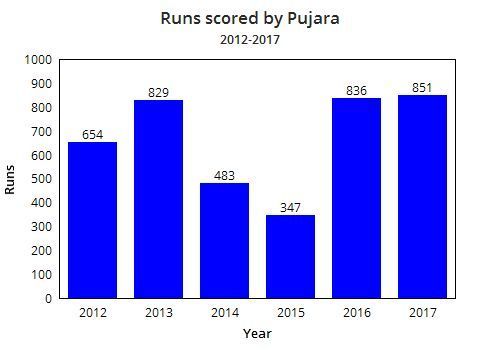
While that average might well come down towards the end of this year, he has already bettered his runs tally for the previous year when he scored 836 runs from 16 innings at an average of 55.73 with the same number of centuries and half-centuries as he has already scored this year.
2012 has been his best year till now when he amassed 654 runs at an average of 81.75 and he followed it up with another immensely successful year in 2013 when he scored 829 runs at an average of 75.36.
2014 was the only year when he witnessed a serious dip in form, managing 483 runs from 20 innings, at an abysmal average of 24.15. But now after a couple of good years and a great home season, one can only say that he is back to his very best.
Why Pujara is the most reliable Indian batsman in Test cricket
A simple comparison with India’s best batsman across all formats, Virat Kohli, shows how Pujara has been outperforming his skipper in the longest format of the game. From 2012 to 2017, Kohli has scored 4167 runs while Pujara has scored exactly 4000 runs.
But Pujara has been much more consistent and enjoys a much better average of 54.79 in comparison with Kohli’s 52.74. Pujara outscored Kohli in 2012, 2013 and this year so far. Pujara’s average even in 2015 was much than Kohli’s but the runs scored were less as he played 4 fewer innings than his skipper.
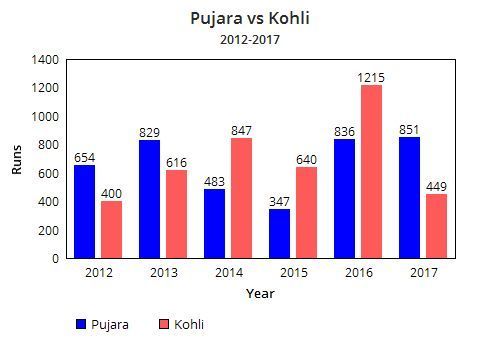
Only the two years where Kohli clearly outperformed Pujara during this period are 2014 and 2016 — in 2014, Pujara endured an abysmal run of form that briefly cost him his place in the side and 2016 was, of course, the year of Virat Kohli when he was on song in all three formats and scored 1215 Test runs in that calendar year.
Even Ajinkya Rahane, despite his incredible consistency in Tests, has a better average than Pujara only in 2014 which is the year when the latter was out of form. It is inexplicable still why, when it comes to Tests, we do not think of Pujara on par with Kohli while making comparisons with the likes of Steve Smith and Joe Root.
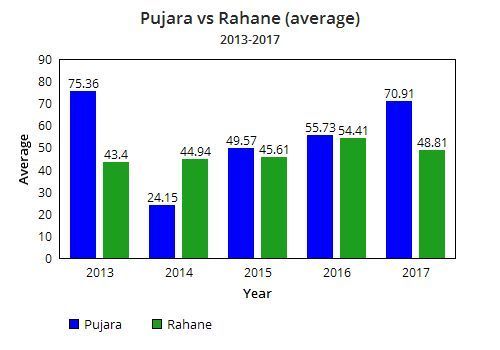
Smith, of course, is in a league of his own since 2014, never having averaged below 70 in a calendar year – though his average for the on-going year is 64.66 – and having crossed the 1000-run mark every year since 2014.
Root follows closely behind, never having averaged below 60 in a year since 2014, barring his average of above 57 in this on-going year.
But given the fact that Root took some time to get going after his debut, Pujara’s Test average of 54.79 for the period of 2012 to 2017, is better than Root’s average of 53.21 and Kohli’s average of 52.74 during this period.
Smith’s average of 64.83 in the last four years is way better than the rest. And since 2012, only Kane Williamson who averages 57.18 is the other batsman with a better average than Pujara.
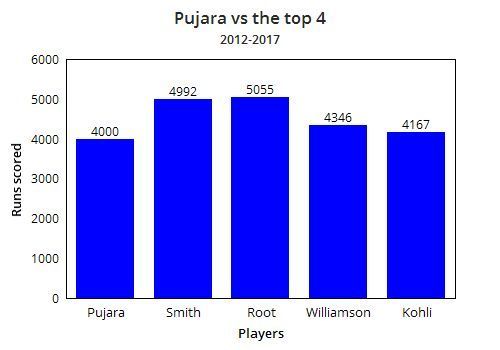
Kohli’s assertion that Pujara is India’s best Test batsman is therefore very true — he is, in fact, one of the very best in the entire world.
Missing the IPL is a blessing in disguise
If one has to look at Pujara’s solid technique and unhurried stance – the way he gets behind the ball to defend or leave – one witnesses a Test batsman with supreme ability who is at his height of efficiency and brilliance.
He is a throwback to the good old days of grace and finesse; in coloured clothing, he looks like a confused teenager who has been forced to commit hara-kiri. Nothing about him is artificial or contrived and unorthodoxy does not come easy to him.
This is why it would be a grave mistake to believe that a player like Pujara will take naturally to a setting like the IPL.
Forcing a player like Pujara to play in the IPL will bring with it the usual risk — in being forced to adapt and change his game, there is a danger of his natural game being hampered.
It is difficult enough for most players to continuously change between the three formats and re-adapt according to the situation. Very few players do it successfully which is why we are seeing the effect of T20 cricket seeping into Test matches.
While some would argue that it is a good thing as more players play positive cricket now leading to a result-oriented approach in Test matches – the number of drawn Tests has significantly gone down in the last few years – the negative influence of T20s on Tests can be ignored at one’s own peril.
On too many occasions now do we see rash shots and unbridled aggression which lead to the downfall of many batsmen in Test cricket. For a batsman like Pujara who is at the top of his game, it is only natural to protect him from the chaotic world of T20 cricket to ensure that his quality and composure remain unaffected.
Good workout and much-needed rest
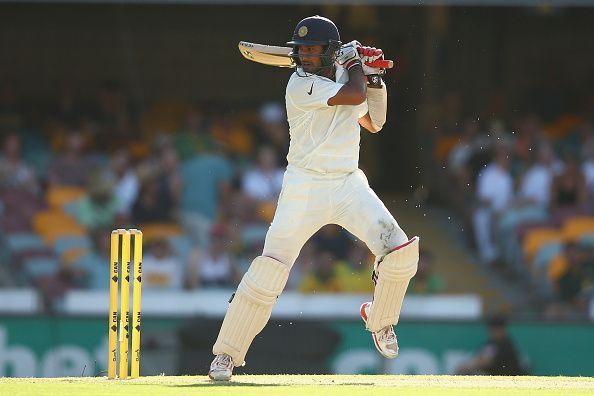
India’s long home season saw them play a lot of Test cricket with stints of limited overs cricket in between. With the Champions Trophy and the IPL over, the series against Sri Lanka now is the beginning of one more tough season which will see India travel quite a lot.
With challenging overseas tours coming up, India would want their specialist Test batsmen to remain fresh with their batteries recharged. For someone like Kohli who plays all the formats of the game, there is no respite.
But India would dearly love a bit of compartmentalization of their priorities and keep away at least a few specialists for each format. When it comes to Tests, Pujara might be that player who needs to be preserved and protected because he is the most important member of the Test team.
In other sports like football, rotating players to protect them from burn-out in a long season with tightly-packed schedules is the accepted norm. With the amount of cricket being played now, India should adopt this strategy of player rotation to give them the much-needed rest.
A long IPL season with frequent matches, endless travel and after-match celebration is extremely demanding and energy-sapping. All the best players in a franchise are expected to play at least 14 matches - two or three more if they make it to the final – within the space of a month and a half.
This is why some much-needed rest for Pujara during that hectic IPL window will always stand him in good stead. He stayed in shape and form by playing some English county cricket this summer.
The schedule was hardly as challenging as he played only five matches for Nottinghamshire, had a good work-out and scored some useful runs for the team. He scored 233 runs from five innings including a century in his second match.
By his own admission, he had immensely enjoyed his time playing county cricket and promised to be back again later.
"It was great to be associated with Nottinghamshire. I enjoyed playing on wickets in England in challenging conditions. Facing fast bowlers/seamers there is a different experience when compared to playing in India. I am happy that I was able to cope well and score runs," Pujara told the reporters.
Pujara also immensely enjoyed his life in England as he could spend some time with his family. Fresh from his break during the IPL season and time spent with his family, Pujara looks hungrier than ever, already doing the bulk of the scoring during the on-going Test series against Sri Lanka.
There is perhaps no formula of success other than to keep doing what is working for you. The IPL can wait for now. Why change something when it is working? There isn’t much of a point trying to fix something which isn’t broken.